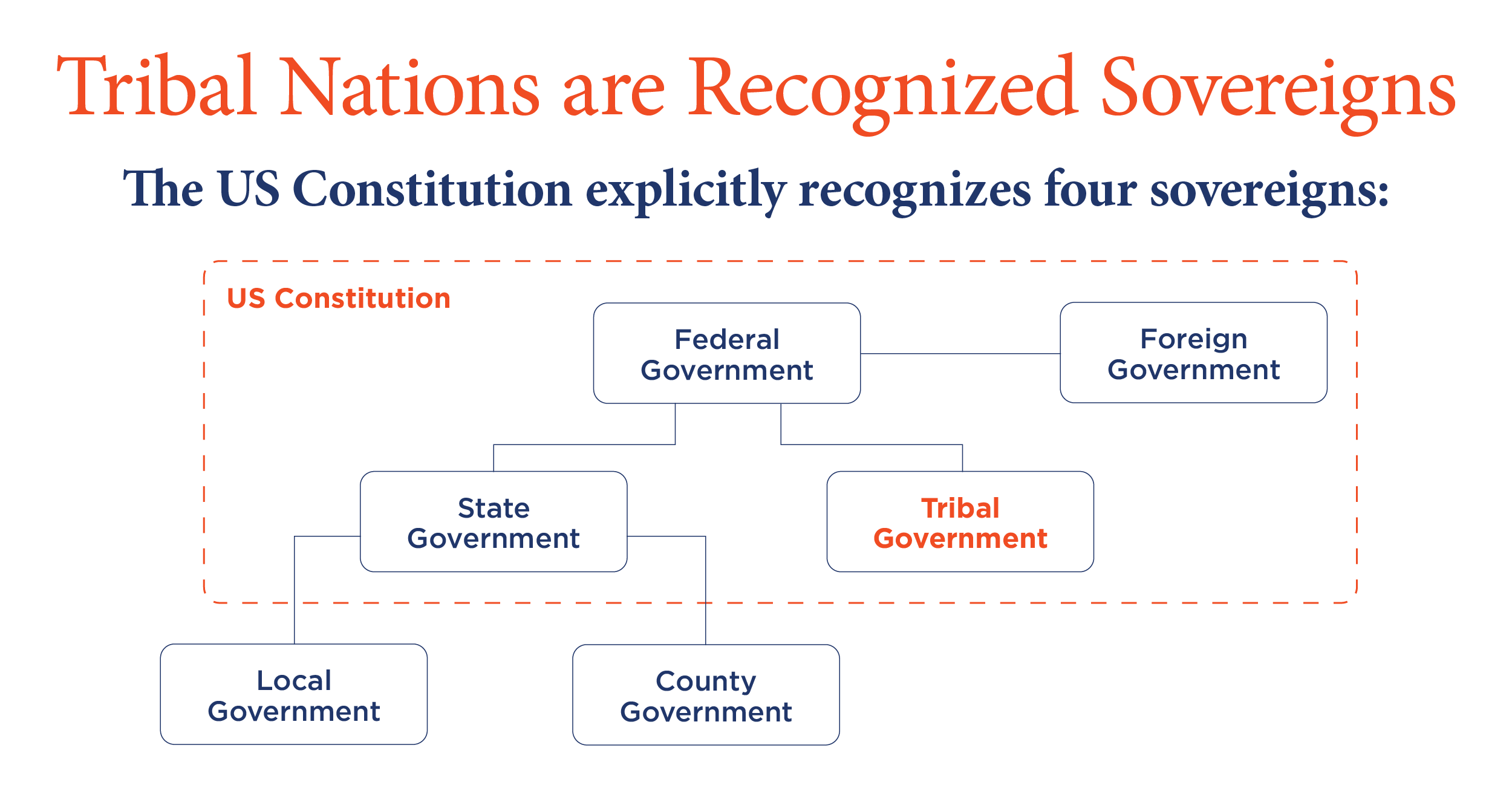
Tribal Sovereignty & Economic Development
About Native American Tribes
Along with federal, state, and foreign governments, Native American Tribes are one of the four sovereigns recognized in the U.S. Constitution. The United States Supreme Court has acknowledged that Tribal governments are the oldest sovereigns on the continent and predate the sovereignty of the Unites States of America.
The federal government currently recognizes 574 Native American Tribes. (1) Hundreds more have been stripped of their federal recognition or are otherwise not recognized by the U.S. government. According to the Indian Commerce Clause of the U.S. Constitution, as sovereign nations located within the borders of the United States, Tribes have the right to “make their own laws and be governed by them.”
As sovereigns, Tribes have many of the same responsibilities as state governments. Among these responsibilities, Tribes must provide for the socioeconomic welfare of their citizens, which they accomplish by:
Building and maintaining infrastructure;
Developing and enforcing rules of personal and business conduct (civil and criminal lawmaking);
Licensing and monitoring individuals and businesses for compliance with their laws (regulation & law enforcement);
Engaging citizens in decision making (elections);
Providing for the needs of their people (education, nutrition, medical care, mental health);
Creating enough revenue to provide for the above.
Takeaway: As governments, Tribes are responsible for providing for the basic needs of their citizens.
Tribal Economic Development
While states and the federal government can fund their operations through taxation, Tribal governments are limited in their ability to do so. Some Tribes have recently implemented sales taxes, hospitality taxes, or food and beverage taxes, (2) but these rely on Tribally owned businesses. Most governments rely on property tax or income tax, which are not feasible for Tribal lands or Tribal employees. However, even if Tribes could levy and collect taxes on their vastly reduced land or relatively few employees, the socioeconomic hardships and financial inequity of life on many reservations would make taxation of any form impractical, punitive, and regressive.
And although the federal government has a trust responsibility to Native American Tribes that is secured by the peaceful treaty process wherein Tribes surrendered the vast majority of their homelands, federal grant funding has fallen short for more than a century, leaving Tribes to fill the gap to provide for their people. This trust responsibility was affirmed in the 1830s via the “Marshall trilogy,” in which the U.S. Supreme Court ruled that when the government entered into treaties with Indian Tribes, it made a promise to protect and enhance Indian Tribes.
Instead of using taxes to generate governmental operating revenue, Tribal governments are in the precarious position of having to own and operate profitable businesses, which are in effect “taxed” at 100 percent, because all business revenue (after operating costs) is transferred to Tribal operating funds, and the business proceeds are then used to fund government operations.
The process of owning and operating businesses to create jobs with livable wages, and to generate revenue to enable a tribe to administer programs, services, functions and activities for tribal citizens according to priorities established by their own government is known as tribal economic development.
Tribes own businesses in a variety of sectors. Tribal economic development exists in the sectors of manufacturing, government contracting, natural resource development, energy, financial services, hospitality, and agriculture, but the most visible example is gaming. Approximately 228 Tribes (fewer than half of those that are federally recognized) operate gaming facilities across 28 states. (3) The revenues from these properties are vastly uneven with 7% of the properties earning 47% of the revenue due to the location of Tribal lands. (4)
Tribal economic development can also be seen in manufacturing, government contracting, natural resource development, energy, financial services, hospitality, agriculture, and more.
Takeaway: Without Tribal economic development, many Tribes would have no way to fund government operations and provide for the basic needs of their citizens.
Obstacles to Tribal Economic Development
Developing and operating Tribal government-owned businesses is a time-consuming and costly undertaking and is different from private sector businesses in several ways. (5)
First, Tribes must pass ordinances specific to the industry in which they plan to operate, which in many cases means developing regulations and an independent regulator to enforce those regulations.
Second, Tribes must raise funds to start their businesses, which is difficult because of the lack of a tax base, and because Tribal lands (called “trust lands”) cannot be used as collateral to secure loans.
Third, most economic development relies on Tribal trust land, which is technically owned by the federal government, and the federal government must oversee (and even approve) contracts related to land use such as natural resource extraction.
In addition to these issues, because of isolation, high unemployment, and the lack of a trained workforce, Tribes are limited in their ability to attract and recruit Tribal members to staff these businesses. Many Tribes solve this problem by using third-party service providers to operate their businesses and provide job training to Tribal members. Ironically, using outside management has undermined Tribal sovereignty in some cases.
First, unions have used the fact that Tribes hire non-Indians as a way to argue that the NLRA applies to Tribes because they are acting as “management” rather than as governments. (6)
Second, false accusations have emerged that imply that Tribes are simply “fronts” for non-Indian business owners, (7) or even organized crime. (8)
The COVID-19 pandemic has highlighted additional obstacles to Tribal economic development – for example, many Tribes have, for decades, relied exclusively on gaming revenue. Although gaming has provided jobs and income to many Tribes, the challenge of relying on face-to-face land-based businesses became apparent in 2020 when all Tribal casinos closed. Billions of dollars of revenue were removed from Tribal government coffers.
The solution to many of these issues is leveraging technology and e-commerce to modernize and expand Tribal economic development. Doing so would allow Tribes to:
Overcome geographic isolation by bringing consumers “virtually” to the reservation;
Better implement job training and education programs;
Reduce dependence on land-based businesses and businesses requiring face-to-face interactions;
Raise capital more easily;
Reduce unemployment.
Takeaway: Obstacles to Tribal economic development include education, infrastructure, and geographic isolation, which are more easily overcome by Tribes leveraging the internet and e-commerce.
Impediments to Tribal E-Commerce
Although some Tribes have entered the e-commerce space selling products ranging from arts and craft to food to financial services, several impediments prevent Tribes from fully harnessing the internet to access consumers beyond the boundaries of their reservations.
First, Native American Tribal lands are the least connected to the internet – only 53% of reservations have high-speed internet. (9) Federal grant programs administered through the Federal Communications Commission are working to change that, but grants must be matched with Tribal funds, and many Tribes cannot afford these matches.
Tribal lands often present significant obstacles to deploying broadband and are expensive to serve. These challenges to deployment on Tribal lands include rugged terrain, complex permitting processes governing access to Tribal lands, jurisdictional issues involving states and sovereign Tribal governments, a lack of the necessary infrastructure, and a predominance of residential, rather than business, customers. High poverty rates and low-income levels on Tribal lands, as well as cultural and language barriers, further inhibit the widespread availability of broadband to Tribal residents. (10)
If Tribes and Tribal citizens cannot access the internet, they cannot use the internet for economic development (or for training and educating their citizens to operate e-commerce businesses.)
Second, a lack of understanding of Tribal economic development has made it difficult for some Tribes to recruit and retain the third-party vendors needed to develop and operate Tribally owned e-commerce businesses. Although outsourcing is commonplace outside of Indian country and although it was extraordinarily successful in Tribal gaming, some Indian Country outsiders view Tribal governments’ sophisticated business decision to outsource as a sign that Tribes don’t or can’t own their businesses.
Finally, even though, as sovereigns, Tribes have the right to make their own laws and be governed by them, including laws that create, operate, and regulate businesses, some state and federal legislative and regulatory authorities have been outwardly hostile to early attempts at Tribal e-commerce, and have tried to misapply state or federal laws to prevent Tribes from using the internet, as if to say, “Tribes belong on the Reservation.”
Takeaway: State and Federal stakeholders need to understand better and respect Tribal sovereignty and Tribal economic development, partnering with Tribal nation building efforts instead of impeding them.
Additional Resources
Presidential Memorandum on Tribal Consultation and Strengthening Nation-to-Nation Relationships
U.S. House Speaker Nancy Pelosi Addresses Native American Policy Changes with NCAI
U.S. Secretary of the Interior Debra Haaland Addresses Tribal Consultation
Bibliography
“List of Federal and State Recognized Tribes.” Natioanl Conference of State Legislatures, Mar. 2020, https://www.ncsl.org/research/state-tribal-institute/list-of-federal-and-state-recognized-tribes.aspx.
Cornell, Stephen E., et al. Two Approaches to Economic Development on American Indian “Taxation.” National Congress of American Indians, https://www.ncai.org/policy-issues/tribal-governance/taxation.
Gaming Tribe Report. National Indian Gaming Commission, 13 Jan. 2020, https://www.nigc.gov/images/uploads/state.pdf.
FY15-FY19 Gaming Revenues by Range. National Indian Gaming Commission, 19 Nov. 2020, https://www.nigc.gov/images/uploads/2019_GGR_Charts_by_Range.pdf.
Cornell, Stephen, and Joseph P. Kalt. “Two Approaches to Economic Development on American Indian Reservations: One Works, the Other Doesn’t.” Joint Occasional Papers on Native Affairs, no. JOPNA No. 2005-02, https://www.honigman.com/media/site_files/111_imgimgjopna_2005-02_Approaches.pdf.
“Tribal Power, Worker Power: Organizing Unions in the Context of Native Sovereignty.” Harvard Law Review, 11 Jan. 2021, https://harvardlawreview.org/2021/01/tribal-power-worker-power-organizing-unions-in-the-context-of-native-sovereignty/.
Barlett, Donald L., and James B. Steele. “Indian Casinos: Wheel Of Misfortune.” Time, Dec. 2002. content.time.com, http://content.time.com/time/subscriber/article/0,33009,1003896,00.html.
Lightman, David. “TRUMP CRITICIZES PEQUOTS, CASINO.” Hartford Courant, 6 Oct. 1993, https://www.courant.com/news/connecticut/hc-xpm-1993-10-06-0000003863-story.html.
Wang, Hansi Lo. “Native Americans On Tribal Land Are ‘The Least Connected’ To High-Speed Internet.” National Public Radio, 6 Dec. 2018, https://www.npr.org/2018/12/06/673364305/native-americans-on-tribal-land-are-the-least-connected-to-high-speed-internet.
Report on Broadband Development in Indian Country, Pursuant to the Repack Airwaves Yielding Better Access for USers of Modern Services Act of 2018. Consumer & Governmental Affairs Burea, et. al., May 2019, https://aipi.clas.asu.edu/sites/default/files/05011019fccreport_on_broadband_deployment_in_indian_country_pursuant_to_the_repack_airwaves_yielding_better_access_for_users_of_modern_services_act_of_2018.pdf.




